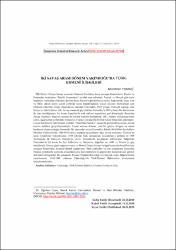| dc.contributor.author | Yamaç, Müzehher | |
| dc.date.accessioned | 2022-05-11T14:33:51Z | |
| dc.date.available | 2022-05-11T14:33:51Z | |
| dc.date.issued | 2019 | |
| dc.identifier.issn | 1309-7660 | |
| dc.identifier.uri | https://doi.org/10.33207/trkede.517350 | |
| dc.identifier.uri | https://app.trdizin.gov.tr/makale/TkRBMU5EZzJOZz09 | |
| dc.identifier.uri | https://hdl.handle.net/20.500.11776/7936 | |
| dc.description.abstract | Birinci Dünya Savaşı sırasında Osmanlı Devletine karşı savaşan Ermeniler’e, Ruslar veFransızlar tarafından “Büyük Ermenistan” devleti vaat edilmişti. Taşnak ve Hınçak gibi terörörgütleri, vatandaşı oldukları devlete karşı Ermeni topluluklarını isyana kışkırtarak, başta Vanve Bitlis olmak üzere çeşitli yerlerde isyan başlatmışlardı. Çıkan olayları durdurmak içinOsmanlı yönetimi, Doğu Anadolu’da bulunan Ermenileri, 1915 yılında Osmanlı toprağı olanSuriye’ye tehcir kararı aldı. Savaş sırasında göç ettirilen Ermeniler’e 1918 yılında bir kararnameile izin verildiğinden, bir kısmı Anadolu’da terk ettikleri topraklara geri dönmüştür. KurtuluşSavaşı süresince düşman ordusu ile birlikte hareket etmişlerdir. 1921 Ankara Anlaşması’ndansonra, işgal edilen yerlerdeki Ermeniler, Fransız ordularıyla birlikte tekrar bölgeden çekilmiştir.Lozan Konferansı’nda Ermeni istekleri “Azınlıklar Sorunu” sırasında görüşülmüş ancak, devletkurma istekleri gerçekleşmemiştir. Lozan sonrası dönem, yeni bir güçler dengesi ve siyasiharitanın oluşturulduğu dönemdir. Bu aşamadan sonra Ermeniler, Kürtler’le birlikte kurduklarıHoybun Cemiyeti’nde, 1926-1930 yılları arasında gerçekleşen Ağrı isyanı sırasında, Türkiye’yekarşı eylemlerde bulunmuştur. 1938 yılında Türk ordusunun İskenderun’a girmesi ve 1939Antlaşması ile Hatay’ın Türkiye’ye devri, Ermenilerin kaygılarını arttırmıştır. BölgedekiErmeniler’in bir kısmı bu kez Lübnan’a ve Suriye’ye, diğerleri ise ABD ve Fransa’ya göçetmişlerdir. Fransa göçü organize etmiş ve Birinci Dünya Savaşı ve işgal sırasında kendileri içinsavaşan Ermenilere, finansal destek sağlamıştır. Türk yetkilileri bu yer değiştirme sırasında;Fransız yetkililerle üzerinde anlaştıkları göç düzenlemeleri ile göçmenleri korumak için gerekliönlemleri almışlardır. Bu çalışmada Fransız Dışişleri Bakanlığı ve Osmanlı Arşiv Belgelerindenyararlanarak, 1918-1940 yıllarına Yakındoğu’da Türk-Ermeni İlişkilerinin incelenmesiamaçlanmaktadır. | en_US |
| dc.description.abstract | The Armenians who fought against the Ottoman State during World War I had been promised a “Greater Armenia” state by the Russians and the French. Terrorist organizations such as Dashnak and Hinchak have led Armenian communities to a rebellion against their states in various places, including Van and Bitlis. In order to halt the emerging events, the Ottoman government decided to relocate the Armenians in Eastern Anatolia to Syria, an Ottoman land in 1915. Armenians who were displaced in the war, since it was allowed by a decree in 1918, to Antep, Urfa and Maraş in Çukurova region, which they have left previously. During the War of Independence, Armenians moved alongside the enemy forces. After the 1921 Ankara Agreement, the Armenians in the occupied territories withdrew from the region again with the French armies. Some have migrated to Cyprus and Egypt, others have been placed in lands under the mandate. At the Lausanne Conference, Armenian wishes were discussed during the "Minorities Issue", but the wish to form a state was not realized. The postLausanne period was the period when a new balance of power and a new political map were established. After this stage, the Armenians together with the Kurds founded the Hoybun Association during the Ağrı riots that took place between the years 1926-1930, and engaged in actions against Turkey. The arrival of Turkish forces in Iskenderun in 1938 and acquisition of Hatay with 1939 Agreement have increased the concerns of the Armenians qAQfurther. This time a portion of the Armenians in the region went to Lebanon and Syria, while others have emigrated to the United States and France. France organized the immigration and provided financial support to Armenians who fought for themselves during the First World War and the occupation. During this relocation Turkish authorities, together with the French authorities, have taken the necessary measures to protect the immigrants. In this study, it is aimed to examine the relations between the Armenian-Turkish relations in the Near East in 1918-1940, by using the documents of French Ministry of Foreign Affairs and the Ottoman Archives. | en_US |
| dc.language.iso | tur | en_US |
| dc.identifier.doi | 10.33207/trkede.517350 | |
| dc.rights | info:eu-repo/semantics/openAccess | en_US |
| dc.title | İki Savaş Arası Dönem Yakındoğu'da Türkermeni İlişkileri | en_US |
| dc.title.alternative | Turkish-Armenian Relations Between Two Wars Period in the Near East | en_US |
| dc.type | article | en_US |
| dc.relation.ispartof | Trakya Üniversitesi Edebiyat Fakültesi Dergisi | en_US |
| dc.department | Fakülteler, İktisadi ve İdari Bilimler Fakültesi, Uluslararası İlişkiler Bölümü | en_US |
| dc.identifier.volume | 9 | en_US |
| dc.identifier.issue | 17 | en_US |
| dc.identifier.startpage | 54 | en_US |
| dc.identifier.endpage | 79 | en_US |
| dc.institutionauthor | Yamaç, Müzehher | |
| dc.identifier.trdizinid | TkRBMU5EZzJOZz09 | en_US |



















